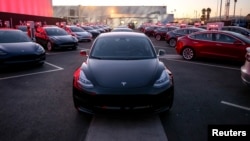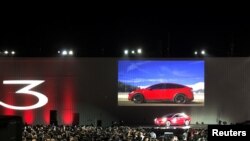For Tesla, everything is riding on the Model 3.
The electric car company’s newest vehicle was delivered to its first 30 customers, all Tesla employees, Friday evening. Its $35,000 starting price, half the cost of Tesla’s previous models, and range of up to 310 miles (498 km) could bring hundreds of thousands of customers into the automaker’s fold, taking it from a niche luxury brand to the mainstream. Around 500,000 people worldwide have reserved a Model 3.
Those higher sales could finally make Tesla profitable and accelerate its plans for future products like SUVs and pickups.
Or the Model 3 could dash Tesla’s dreams.
Much could go wrong
Potential customers could lose faith if Tesla doesn’t meet its aggressive production schedule, or if the cars have quality problems that strain Tesla’s small service network.
The compact Model 3 may not entice a global market that’s increasingly shifting to SUVs, including all-electric SUVs from Audi and others going on sale soon. And a fully loaded Model 3 with 310 miles of range costs a hefty $59,500; the base model goes 220 miles (322 km) on a charge.
Limits on the $7,500 U.S. tax credit for electric cars could also hurt demand. Once an automaker sells 200,000 electric cars in the U.S., the credit phases out. Tesla has sold more than 126,000 vehicles since 2008, according to estimates by WardsAuto, so not everyone who buys a Model 3 will be eligible.
“There are more reasons to think that it won’t be successful than it will,” says Karl Brauer, the executive publisher for Cox Automotive, which owns Autotrader and other car buying sites.
Always part of Tesla plans
The Model 3 has long been part of Palo Alto, California-based Tesla’s plans. In 2006, three years after the company was founded, CEO Elon Musk said Tesla would eventually build “affordably priced family cars” after establishing itself with high-end vehicles like the Model S, which starts at $69,500. This will be the first time many Tesla workers will be able to afford a Tesla.
“It was never our goal to make expensive cars. We wanted to make a car everyone could buy,” Musk said Friday. “If you’re trying to make a difference in the world, you also need to make cars people can afford.”
Tesla started taking reservations for the Model 3 in March 2016. Musk said more than 500,000 people have put down a $1,000 deposit for the car. People ordering a car now likely won’t get it until late 2018. Cars will go first to employees and customers on the West Coast; overseas deliveries start late next year, and right-hand drive versions come in 2019.
Challenges to deliver
But carmaking has proved a challenge to Musk. Both the Model S and the Model X SUV were delayed and then plagued with pesky problems, like doors that don’t work and blank screens in their high-tech dashboards.
Tesla’s luxury car owners might overlook those problems because they liked the thrill of being early adopters. But mainstream buyers will be less forgiving.
“This will be their primary vehicle, so they will have high expectations of quality and durability and expect everything to work every time,” said Sam Abuelsamid, a senior researcher with Navigant Research.
The Model 3 was designed to be much simpler and cheaper to make than Tesla’s previous vehicles. It has one dashboard screen, not two, and no fancy door handles. It’s made primarily of steel, not aluminum. It has no instrument panel; the speed limit and other information normally there can be found on the center screen. It doesn’t even have a key fob; drivers can open and lock the car with a smartphone or a credit cardlike key.
‘Manufacturing hell’
Still, Musk said he’s expecting “at least six months of manufacturing hell” as the Model 3 ramps up to full production. Musk wants to be making 20,000 Model 3s per month by December at the carmaker’s Fremont factory.
Musk aims to make 500,000 vehicles next year, a number that could help Tesla finally make money. The company has only had two profitable quarters since it went public in 2010. But even at that pace, Tesla will remain a small player. Toyota Motor Corp. made more than 10 million vehicles last year.
Abuelsamid said even if it doesn’t meet its ambitious targets, Tesla has done more than anyone to promote electric vehicles.
“A decade ago they were a little more than golf carts. Now all of a sudden, EVs are real, practical vehicles that can be used for anything,” he said.












